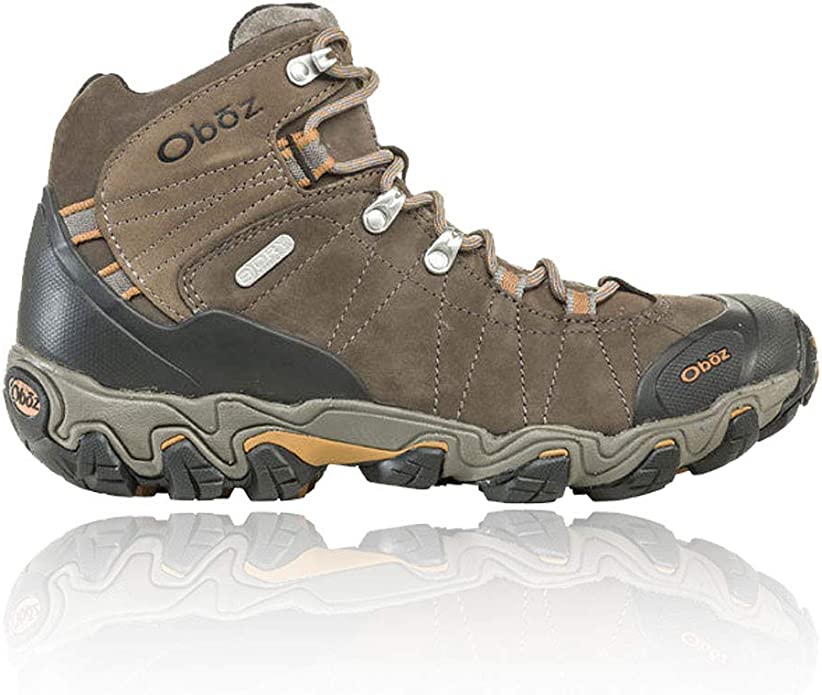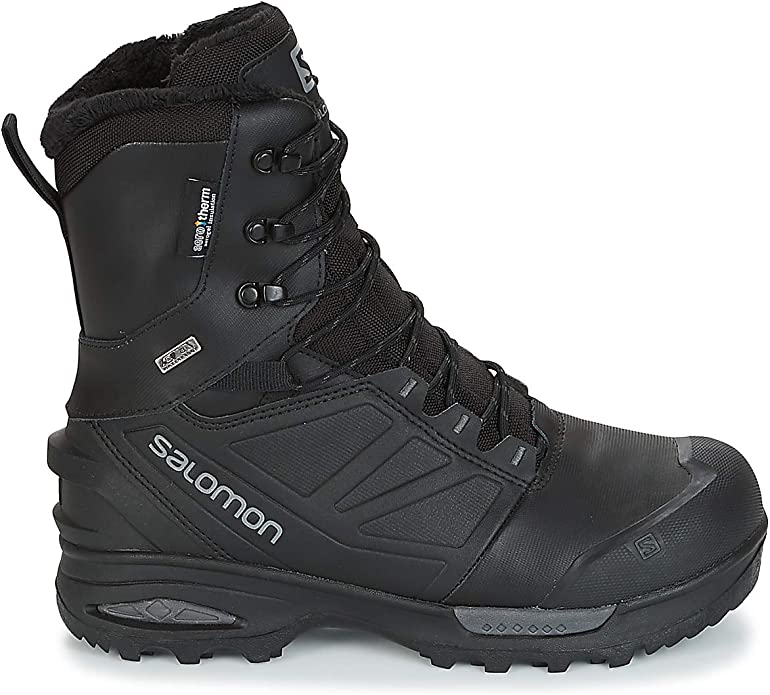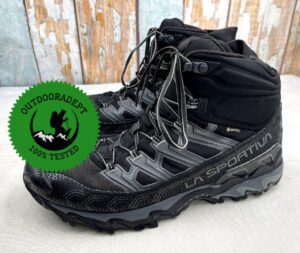Hiking is a great year-round activity, but winter outdoor excursions require modifying your equipment to ensure protection from harsh weather and to retain warmth.
In my early hiking days, I once used regular hiking boots for a snowy mountain hike, only to realize they lacked sufficient insulation to shield my feet from the cold.
I soon purchased quality winter hiking boots, which not only kept my feet warm but also provided the necessary traction for safe winter adventures.
Here’s our list of the top ten winter hiking boots for 2024.
The Verdict – Our Recommendation
The lightweight bamboo insulation is innovative; these boots really held up and performed well over all types of frozen terrain.

When considering all of the best winter hiking boots, the pair we liked the most was the KEEN Revel 4 Mid-Height Snow Boot. KEEN always puts out good quality boots and stands behind their product.
I’m also a big fan of the wide-toe box, which accommodated my mid-weight wool socks well. The waterproof breathable membrane was a bonus, and my feet didn’t feel sweaty at all when wearing them.
To pinpoint the top 11 winter hiking boots, we evaluated 16 pairs across various locations in the United States and Europe. Each pair was tested on diverse terrains such as flat, rocky, muddy, and gravel surfaces. We assessed their performance in different weather conditions, focusing on waterproofing in rain, insulation in snow, and overall temperature management. Our team conducted multi-day tests, complemented by assessments from independent experts, to understand the boots’ break-in periods. The boots were rated based on temperature regulation, insulation, traction, waterproofing, cuff design, outsole quality, and lug effectiveness. After aggregating the average scores, we also factored in external feedback and warranty information for our final recommendations.
Our Top Recommended Winter Hiking Boots
1) KEEN Revel 4 Mid-Height Snow Boot
200g of insulation inside protects from the weather up to -25 (32°C). The best thing about the insulation is that it’s made of bamboo, so it’s very lightweight and doesn’t add extra bulk.

KEEN is renowned for creating top-notch winter hiking boots and outdoor footwear, and their KEEN Revel IV winter boots live up to this reputation.
These boots come equipped with everything you need to keep your feet warm and dry on winter hikes. They’re also crafted to pair effortlessly with most hiking microspikes.
In my experience, KEEN footwear typically features a wider toe box compared to other brands. This is something I really value in the winter, as it provides enough space for thick socks without causing them to bunch up or rub uncomfortably around your toes.
PROS
CONS
2) Oboz Bridger Mid B-Dry Hiking Boot
Their 200g of Thinsulate insulation keeps your feet feeling great in harsh temperatures, and they’re fully waterproof.

The Oboz Bridger Mid B-Dry Hiking Boot is very durable and has an outsole that provides excellent traction on cold surfaces. These PAC boots also have great arch support, which prevents pain and injury.
I find that this brand tends to run a bit on the smaller side, so I went with a half a size bigger than normal, and they worked out well, even when paired with thick wool socks. I recommend reading the reviews on sizing before making the purchase.
PROS
CONS
3) Salomon Toundra Pro Climasalomon
In addition to having waterproof protection, the inside of the PU-leather boot has Aerogel insulation, which will keep your feet toasty up to -40°F, making them some of the best winter shoes you can find.

Salomon’s winter hiking boots are top-notch for women and men, providing necessary protection and style. They’re great for shock absorption and feel light.
While I’d like more colors than just black, their great performance makes up for the lack of variety.
PROS
CONS
4) Merrell Thermo Chill Mid Waterproof Snow Boot
In addition to waterproofing, they also have antimicrobial properties that prevent bad odors and a very cushioned midsole for extra comfort.

The Merrell Thermo snow boots are more budget-friendly compared to many other options, making them a great affordable choice for winter hiking. They’re equipped with 200g of insulation to keep your feet warm in most winter conditions.
From my experience, I found that the shaft of these boots is slightly lower compared to other brands. While this isn’t always an issue, I did encounter some wetness seeping in when I used them in deeper snow.
Based on this, I’d suggest they might not be the best option for extreme snow conditions or for crossing icy streams.
PROS
CONS
5) Salomon Outblast Thinsulate Climasalomon Winter Boots
They have 200g of Thinsulate insulation, which means they can handle even the most extreme conditions as winter rolls in.

Here’s another pair from Salomon that’s sure to keep your feet dry and safeguarded on your hiking adventures. Their design is sleek and modern, resembling a sneaker, yet they’re incredibly effective at keeping your toes warm.
Speaking from my experience, as someone with narrow feet, I found these boots to fit me better than most. But, if you have wider feet, you might find the fit a bit snug since they don’t come in wide sizes. I’d suggest trying them on in person to ensure a comfortable fit.
PROS
CONS
6) Merrell Thermo Kiruna Mid Shell WP Boots
These popular winter hiking boots have both 200g of insulation and a fleece lining to help keep your feet extra warm.

These boots come with a heat-reflecting insole, which is a clever addition. It works by reflecting your body heat back towards your feet, ensuring they stay warm.
The lacing system is designed with metal hooks for a firm and adjustable fit, making it easy to tailor them to your feet’s comfort. What’s more, they’re offered in both men’s and women’s sizes and in several fashionable colors.
From my own experience, I tested them out on a full-day hike through fresh snow. I can confidently say they’re comfortable, keeping my feet both warm and dry for the entire hike.
PROS
CONS
7) Lowa Renegade GTX Mid-Hiking Boot
Not only will they protect you in cold weather and slippery surfaces, but the leather uppers have a Gore-Tex membrane that makes them some of the best winter hiking boots in terms of waterproofing.

Lowa Renegade Gtx Mid is a bit of an investment for your winter kit but is worth it for its protection and performance. If you’re looking for a mountaineering boot, you should consider these.
I like Lowa’s selection of colors for these boots, as they have many options that aren’t plain black or brown. They’re lightweight because of the Monowrap midsoles that help reduce the overall weight of the boots.
Our findings show these waterproof boots also have exceptional arch support and give great stability. I recommended them to a friend who was suffering from plantar fasciitis, and he said they helped him tremendously.
PROS
CONS
8) Timberland Chocorua Trail Mid Waterproof Hiking Boot
They’re made in the USA of premium full-grain leather that’s also waterproof, with a TimberDry membrane that makes them breathable.

Chocorua Trail winter hiking boots have the popular Timberland brand name and classic style for which the company is well-known.
Although not the warmest boot option out there, these boots are versatile and look good both on and off the rocky trails. They have Thinsulate inside to help you stay warm but do not make your feet sweaty or feel overly hot.
After trying these winter boots, I think they’re better for colder conditions but not extremely freezing temperatures. They work well on packed snow, but you’d probably want more of a snow boot for deep snow conditions.
The waterproofing does hold up well, though, and kept me dry during my hiking through muddy terrain.
PROS
CONS
9) Columbia Bugaboot III Snow Boot
Among the best women’s and men’s winter hiking boots on the market, the Bugaboot III has a modern look that’s very sleek and looks great on winter trails.

Columbia is known for its cold weather gear; these insulated winter hiking boots with a waterproof breathable membrane are no exception. With an insulation weight of 200g, these have enough insulation to provide incredible warmth than many other winter hikers.
I liked the deep lugs and lug pattern on the Omni-Grip outsole and found that it provided some of the best traction on ice. My feet were happy, and I felt safe walking effortlessly across the winter terrain.
The mid-calf height also works well in snowy conditions, whether in the mountains or off-trail.
PROS
CONS
10) Manfen Thermator Mid-Rise Waterproof Hiking Boots
These pretty standard hiking boots have good traction, cushioned ankle support, and a rubber outsole that holds up against rough terrain and sharp rocks.

The great price of these winter boots makes them hard to pass up if you’re looking for something to wear when hiking in cold conditions.
The toe bumper and heel guard also help to provide additional protection against sharp obstacles on the trail.
I found this pair to be a good waterproof option that kept melted snow and mud away from my thicker socks. However, for the price, I’m not sure how well they’ll hold up in the long term.
PROS
CONS
Winter Hiking Boots Buyer’s Guide

In selecting the best winter hiking boots for our list, we focused on several key features that determine a boot’s effectiveness in winter hikes and cold weather.
Temperature Rating
Choose boots that prevent cold toes, even on the chilliest days. Most winter hiking boots offer sufficient insulation to protect against the cold in sub-zero temperatures. Always verify the manufacturer’s temperature rating to ensure it aligns with your needs.
Insulation Weight
The heavier the insulation, the warmer the boots in freezing conditions. Our recommended winter boots all feature a minimum of 200-gram insulation. Check the insulation weight when buying to keep your toes warm.
Traction
Winter hiking often involves snow and ice. Your boots should offer reliable traction on various surfaces like rocks, dirt, and ice to prevent slipping and potential injuries.
Waterproofing
In winter, waterproof insulated boots are essential. With ice and snow underfoot, and the possibility of melting snow, your feet need to stay dry to avoid frostbite or other hazards. Ensure your boots have a waterproof membrane.
Additionally, consider using a waterproofing spray for added protection.
Cuff
Choose boots with a snug cuff that bridges the gap between your ankle or calf and the boot. This design prevents snow and water from entering, keeping your feet drier and warmer.
Gusseted Tongue
This design resembles a regular boot tongue but is sewn into the sides of the boots. It works similarly to the cuff in preventing water from entering, aiding in keeping your feet dry and protected.
Lugs
Opt for winter hiking boots with aggressive lugs. They enhance grip in winter conditions, offering improved traction on snow and ice, thereby ensuring safer winter hikes.
Outsole
The outsole of your winter hiking boots should also contribute to superior traction on ice, snow, and other frozen terrains. A Vibram sole is commonly found on top-quality winter boots due to its excellent grip on cold surfaces.
Comparison Table
| BOOT | PRICE | Insulation |
|---|---|---|
| KEEN Revel 4 | $190 Backcountry» Check on Amazon» | KEEN.WARM insulation, -25°F |
| Oboz Bridger Mid BDry | $140 REI» $200 Backcountry» Check on Amazon» | No |
| Salomon Toundra Pro Climasalomon | $200 REI» $200 Backcountry» Check on Amazon» | Aerotherm, -40°F |
| Merrell Thermo Chill | $130 REI» Check on Amazon» | Yes, 200g Thinsulate |
| Salomon Outblast Thinsulate Climasalomon | $150 Backcountry» Check on Amazon» | Yes, 200g Thinsulate |
| Merrell Thermo Kiruna Mid Shell | Check on Amazon» | Yes, 200g Thinsulate |
| Lowa Renegade GTX Mid | $255 REI» $255 Backcountry» Check on Amazon» | Yes, GORE-TEX Panda fleece insulation |
| Timberland Chocorua | $150 REI» Check on Amazon» | Yes, Primaloft 200g |
| Columbia Bugaboot III Snow Boot | $130 REI» Check on Amazon» | Yes, 200 g Aconic AC-Q200 |
| Manfen Thermator | Check on Amazon» | Yes, 200g Thinsulate |
Do You Need Insulated Boots for Winter Hiking?
Whenever you’re hiking in winter, it’s crucial to wear insulated boots, particularly with ample insulation around the toes. This is key to preventing your toes from freezing during your hike.
In snowy conditions, your focus should be on finding proper snow boots. These are specifically designed to handle the challenges of snow-covered trails.
FAQs
I’d strongly advise against using winter hiking boots in the summer. Their synthetic insulation can make your feet sweat excessively, turning your hike into a rather uncomfortable experience. And trust me, even those with a waterproof breathable membrane might not be the best fit for summer trails.
For winter hikes, a Gore-Tex membrane is essential in your boots for keeping water out. But remember, just Gore-Tex isn’t enough – your boots should also have proper insulation to keep your feet warm.
When you’re picking out winter hiking boots, look for ones that not only provide excellent traction but also keep your feet warm and dry without becoming uncomfortable, even on long walks. I’ve found that both treated leather and synthetic boots work great for winter hiking.








